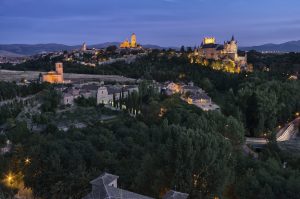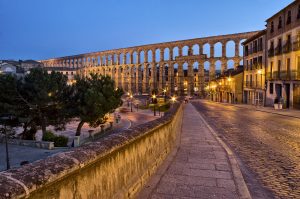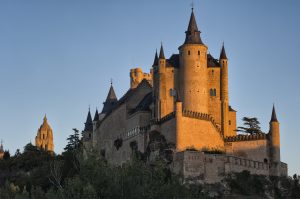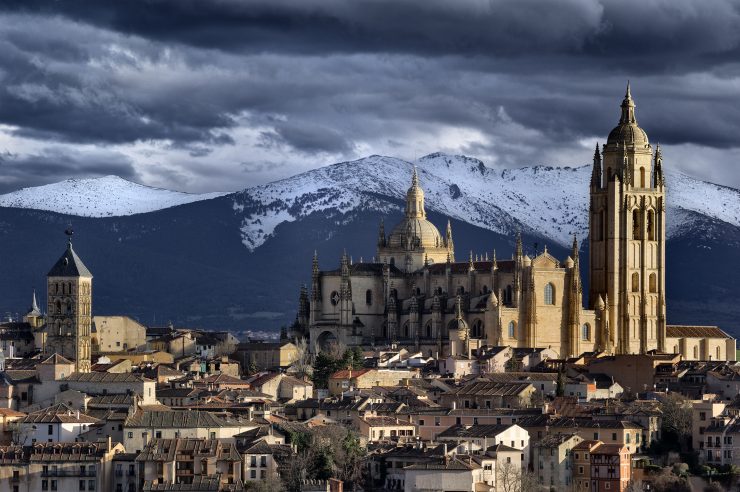Do you want to read in English? Click here.
VERSIÓN EN ESPAÑOL
SEGOVIA, CIUDAD PATRIMONIO DE LA HUMANIDAD

En diciembre de 1985, la UNESCO incluyó en su listado de Ciudades Patrimonio a la «antigua ciudad de Segovia y su acueducto romano». Razones no faltaban pues la belleza de su enclave, de su entorno, de sus edificios, arboledas y calles parece pesar bastante en una decisión que se basa precisamente en tales valores.
Sin embargo, la ciudad no es sólo el elemento físico. Este puede verse aquí y ahora. Pero el elemento humano que ha hecho la ciudad, no se ve y, sin embargo es la esencia misma de la ciudad.
Segovia es así porque desde ella Alfonso X estudiaba el firmamento. Porque Quevedo se inspiró en sus espacios –y aún en sus gentes- para escribir el Buscón don Pablos. También porque en esta ciudad, fue proclamada Reina de Castilla Isabel I, la Católica, con lo que este hecho supuso para la Historia. Y porque aquí se imprimió un libro por primera vez en España.
A Segovia la han hecho los místicos Juan de la Cruz y Teresa de Jesús; y los valientes guerreros Juan Bravo, el Comunero, o Día Sanz y Fernán García, conquistadores de Madrid a los moros. Pero también a Segovia la han dado forma y sentido la palabra de María Zambrano; los paseos, tertulias y clases de Antonio Machado en el Instituto; Gómez de la Serna desvelando «El secreto del Acueducto» y Louis Proust investigando en el Real Laboratorio de Química a la sombra del Alcázar.
Segovia tuvo una populosa aljama hebrea, con personalidades tan destacadas como Abraham Senneor, juez mayor de las juderías de Castilla, y en la morería, el alfaquí Iça de Gebir escribía su importantísima obra Kitab segoviano o Breviario sunní mientras el Prior del cercano Monasterio de Santa Cruz, Tomás de Torquemada, daba vueltas a sus ideas urdiendo una buena limpieza del entorno religioso.
También Segovia fue próspera por su comercio internacional de lana y su potente industria textil, que procuró durante siglos un bienestar a los segovianos que se refleja en la arquitectura de la ciudad y, sobre todo en los Archivos que celosamente guardan el pasado escrito.
 Pero ahora, hoy mismo, se sigue haciendo Segovia aunque su economía esté basada en los atractivos culturales y gastronómicos que ofrece a sus visitantes. La ciudad cuenta con interesantes museos y salas de exposiciones, pero también con afamados mesones y restaurantes en los que degustar las especialidades de la cocina segoviana.
Pero ahora, hoy mismo, se sigue haciendo Segovia aunque su economía esté basada en los atractivos culturales y gastronómicos que ofrece a sus visitantes. La ciudad cuenta con interesantes museos y salas de exposiciones, pero también con afamados mesones y restaurantes en los que degustar las especialidades de la cocina segoviana.
Las calles y las plazas de la ciudad se convierten varias veces al año en escenario de actividades artísticas: Semana Santa, Titirimundi, Folk Segovia, Festival Internacional, etc. son algunas de las citas culturales más importantes del año.

SEGOVIA, PATRIMONIO DE LA HUMANIDAD
Segovia, declarada Patrimonio de la Humanidad por la UNESCO en 1985, es una ciudad milenaria situada a tan sólo 87 kilómetros de Madrid.
Considerada como una de las ciudades más bellas del mundo por su extraordinaria configuración arquitectónica, ha sido protagonista de grandes acontecimientos a lo largo de la historia de España, y hoy se distingue por su dinamismo cultural, su gastronomía, fiestas y tradiciones, además de por su impresionante Acueducto Romano. Rodeada por el cinturón verde que forman los valles de los ríos Eresma y Clamores, la ciudad situada a 1.005 m de altitud goza de una atmósfera cristalina, que ha permitido que Segovia invoque la luz como uno de sus más preciados atractivos.
Rutas recomendadas
- Segovia, Patrimonio de la Humanidad
Descubre el impresionante eje principal del casco histórico de Segovia: el Acueducto, la Calle Real, la Casa de los Picos, la Iglesia de San Martín, la Catedral, el Alcázar…
- La Judería
En este recorrido por las estrechas y sinuosas calles del barrio hebreo, podrás conocer el rico legado cultural judío de Segovia: la Antigua Sinagoga Mayor, el Centro Didáctico de la Judería, la Casa del Sol… son lugares clave para entender el pasado de la ciudad.
- Valle del río Eresma
Las orillas del río Eresma esconden grandes tesoros naturales y monumentales. No lo dudes y adéntrate en su valle para conocer el coqueto barrio de San Lorenzo, los Monasterios de San Vicente el Real y El Parral, el Romeral de San Marcos, la Vera Cruz, o el Santuario de la virgen de la Fuencisla, entre otros muchos atractivos.
- El Acueducto y Segovia extramuros
Con esta ruta podrás, guiado por el propio Acueducto, conocer los importantes monumentos que rodean a la famosa obra de ingeniería romana en su recorrido extramuros: la Iglesia de San Justo, la Plaza del Salvador o el Monasterio de San Antonio el Real son sólo algunos ejemplos de lo que encontrarás durante tu paseo.
- La Muralla
Camina por siglos de historia para conocer las diferentes culturas que convivieron en Segovia y contempla las extraordinarias vistas que nos ofrece la ciudad desde sus amplios miradores de piedra. Podrás conocer lugares como el Jardín de los Poetas o la Puerta de Santiago (donde encontrarás la Colección de Títeres de Francisco Peralta), e incluso acceder a la puerta de San Andrés, donde está ubicado el Centro de Interpretación de la Muralla.
Lo que no te puedes perder
- ACUEDUCTO ROMANO
Con sus 16.220 metros de longitud, 28,10 metros de altura, y más de 2000 años de vida, es posiblemente el acueducto más espectacular y mejor conservado de todos los que hubo en el imperio romano, aunque la leyenda segoviana dice que su auténtico constructor fue el diablo…
- ALCÁZAR
Edificado en el siglo XI sobre los restos de una fortaleza romana, se erige como un buque imaginario entre los valles de los ríos Eresma y Clamores. Con su aspecto de castillo de cuento de hadas se ha convertido en uno de los monumentos más visitados de España.
- CATEDRAL
Conocida como la dama de las catedrales al ser ésta uno de los más bellos ejemplos de arquitectura gótica tardía. Su construcción comenzó en 1525. La Catedral es el lugar de reunión favorito de las cigüeñas, que suelen descansar sobre sus pináculos.
- GASTRONOMÍA
Segovia es famosa por los asados, legumbres, repostería y vinos que aquí se producen: magníficos caldos de mesa de elaboración local junto a otros incluidos en las denominaciones de origen Ribera de Duero y Rueda.
Segovia, ciudad cultural
Los segovianos se consideran los castellanos con el carácter más abierto, acogedor y festivo de la región. Esa forma de ser ha permitido que todo aquel que se acerque a cualquiera de las muchas manifestaciones culturales que se celebran en calles, plazas y patios sean bienvenidos. Éstas son algunas de las más destacadas:
- SEMANA SANTA
Declarada de interés turístico regional, la Semana Santa segoviana es especial por la belleza de sus procesiones y por el sentimiento religioso que transmite. Desde el sobrecogedor Vía Crucis nocturno del Miércoles Santo en la huerta carmelita de San Juan de la Cruz, a la gran Procesión de los Pasos de Viernes Santo.
- TITIRIMUNDI – mayo
Desde 1985 Segovia acoge el que para muchos es el festival de títeres más famoso y prestigioso del mundo. Durante una semana del mes de mayo, calles, patios, plazas y teatros se llenan de magia en espectáculos pensados para todas las edades.
- FOLK SEGOVIA – junio
Todos los años, a finales de junio, las calles de la ciudad acogen el encuentro de grupos de música de raíz venidos de diversos puntos de España, y otros lugares más allá de sus fronteras.
- FESTIVAL DE SEGOVIA – julio
Hace más de 35 años nació este festival con el objetivo de hacer llegar la música clásica a segovianos y visitantes. Todos los meses de julio la ciudad se vuelca con este gran evento que programa para todos los gustos y sensibilidades musicales.
- HAY FESTIVAL – septiembre
Segovia es sede de este famoso festival literario de origen galés. Durante unos días, y de la mano de los mejores escritores, pensadores y creadores del mundo, la ciudad se transforma en escenario para el diálogo y el intercambio de ideas e historias.
- MUCES – noviembre
La Muestra de Cine Europeo Ciudad de Segovia MUCES, en noviembre, es sin duda una de las muestras más interesantes para que el gran público conozca antes de su estreno el cine europeo de mayor calidad que se realiza cada año.
ENGLISH VERSION
SEGOVIA, WORLD HERITAGE SITE
Segovia is a city full of ancient history, which origin dates back to Celtiberian tribes, who built it in a craggy rock made of limestone. The height of the cliff is over 1000 meters above sea level. The silhouette drawn on the Castilian clean sky has been compared, from the 16th century, to a ship made of stone, waiting for the two rivers that flow on its feet (Eresma and Clamores) to flood the valley, so it can sail to the vast sea of the plateau.
Even to this day the origin of the city remains a mystery. We know for sure that it was inhabited in the pre-roman era. Rome left its indelible mark by building of the Aqueduct. Repopulated in 1088, Segovia gathers centuries of brilliant History. The textile industry and wool trading made the city thrive, layered in two physical and social levels: the fortified city, inhabited by noblemen and clergy, and the suburbs – in the Eresma and Clamores banks – where the productive activity was developed. During the 12th and 17th centuries, this prosperity brings about the building of many churches, convents, strongholds, palaces and other elements belonging to the monumental compound we can still enjoy nowadays. The economical decadence paralyses to a certain extent the artistic development, but favours the preservation of its monumental Patrimony. From the last decades of the 19th century, the city restores its remarkable legacy, and nowadays it is shown proudly to the visitor.
A city to enjoy calmly and to return to Segovia. It has received every official appreciation for its artistic and monumental richness, for the transparency of its light, for the openness of the atmosphere wrapping it, and for the lushness of the encircling wood that, in contrast to the ochre colour of dry stone, enhances it as a green oasis.
A Real Orden issued in a remote October the 11th of 1884, named the Aqueduct Monumento Histórico Artístico (Historical-artistic monument). This honourable name was given, as years passed by, to several monuments of the city. Finally in 1985 the UNESCO culminated the process in the naming of Segovia as a World Heritage Site.
SEGOVIA, WORLD HERITAGE SITE
Segovia, declared World Heritage Site by UNESCO in 1985, is a city over two thousand years old located only 87 kilometers (54.06 miles) from Madrid. Considered one of the most beautiful cities in the world due to its extraordinary architectonic configuration, it has played a leading role throughout the history of Spain and it is nowadays distinguished among other cities because of its cultural dynamism, gastronomy, traditions, popular festivals and, above all, for its impressive Roman Aqueduct.
Segovia is surrounded by a green belt formed by the Eresma and Clamores rivers. The city, 1005 meters above sea level, enjoys a crystalline atmosphere that makes its light one of its most precious treasures.
Recommended routes
- Segovia, World Heritage Site
Discover the impressive historical centre in the old quarter of Segovia: the Aqueduct, the Calle Real [Royal Street], the Casa de los Picos [Diamond Tip House], San Martín’s
Church, the Cathedral, the Alcázar, The Antonio Machado House Museum or The Francisco Peralta’s Marionette Collection.
- The Jewish Quarter
During this route along the narrow, winding streets of the Hebrew district, the visitor will witness the richness of the Jewish cultural legacy in Segovia: the old Main Synagogue, The Jewish Quarter Visitor’s Centre, the Casa del Sol [House of the Sun], etc. are musts for understanding the city’s past.
- The Eresma Valley
The banks of the river Eresma hide a wealth of natural and monumental treasures. We invite the tourist to explore its valley to discover San Lorenzo quarter, the Monasteries of San Vicente el Real and Santa María del Parral, San Marcos Garden, The Veracruz Church, the Sanctuary of Nuestra Señora de la Fuencisla , or The Mint, among many others …
- The Aqueduct and outside the Walled City
Along this itinerary —and following the Aqueduct as a guide—, the visitor will contemplate the magnificent monuments which surround this fabulous piece of Roman engineering work along its route outside the heart of the city: San Justo Church, El Salvador Square or the Monastery of San Antonio el Real are only some examples of what the tourist will find along the way.
- The City Wall
Walking through centuries of history will allow the visitor to become familiar with the different cultures that coexisted in Segovia. Gaze at the extraordinary sights that the city offers from its wide stone viewpoints and enjoy sites like the Jardín de los Poetas [the poets’ garden] or the Puerta de Santiago [Santiago Gate]. You can even enter the Puerta de San Andrés [San Andrés Gate], where the Centro de Interpretación de la Muralla [The City Wall Information Point] is currently located.
What not to miss



- ROMAN AQUEDUCT
With 16220 metres in length and 28.10 metres in height, the more than 2000 year-old Aqueduct is probably the most spectacular and best preserved aqueduct of any erected by the Roman Empire, although, interestingly enough, the Segovian legend dictates that the devil was the real architect.
- THE ALCÁZAR
Built during the 11th century over the remains of a Roman fortress, the Alcázar stands like an imaginary ship sailing between the valleys formed by the Clamores and Eresma rivers. With a clear resemblance to a fairy tale castle, it has become one of the most visited monuments in Spain.
- THE CATHEDRAL
It is one of the most beautiful examples of late Gothic architecture, which has led it to be known as “Dame of the Cathedrals”. Its construction began in 1525 and it is a favored meeting point for storks, which usually rest on its pinnacles.
- GASTRONOMY
Segovia is well known for its traditional roasts, legumes, confectionery and wines of local production: excellent table wines are produced in Segovia along with others within the Guarantees of Origin Ribera de Duero and Rueda.
Segovia, Cultural City
People from Segovia are considered the friendliest, warmest and liveliest
citizens of Castille and Leon. Their charming character makes anyone who is interested in attending any of the different cultural events held in the streets, squares and courtyards are very welcome. Some of the most outstanding celebrations in our city are:
- EASTER
Declared “Festival of Regional Tourist Interest”, the Easter Week in Segovia is special owing to its processions and the religious emotion they transmit. From the awesome Holy Wednesday Via Crucis night in the Carmelite San Juan de la Cruz Garden to the magnificent Procession “de los Pasos” celebrated on Good Friday.
- TITIRIMUNDI -May
From 1985 Segovia has held what is considered by many the most famous and prestigious international puppet theatre festival in the world. During a week in May, streets, courtyards, squares and theatres are filled with magic in shows conceived for every type of audience.
- FOLK SEGOVIA – June
Every year, at the end of June, the streets of our city host the meeting of groups playing “Roots Music” from different parts of Spain and other countries.
- FESTIVAL DE SEGOVIA – July
This festival was born more than 35 years ago with the aim of bringing classical music closer to people from Segovia and its visitors. Every July the city throws itself into this great event which satisfies all musical tastes and sensibilities.
- HAY FESTIVAL – September
Segovia is the venue for this famous Welsh literary festival. For some days, the city provides the backdrop for intellectual dialogue and the exchange of ideas and stories; during this period, the city plays host to some of the best writers, creators and thinkers in the world.
- MUCES – November
MUCES (Segovia European Film Festival) is undoubtedly one of the most important film festivals treating viewers to high quality European cinema before their premiere.

